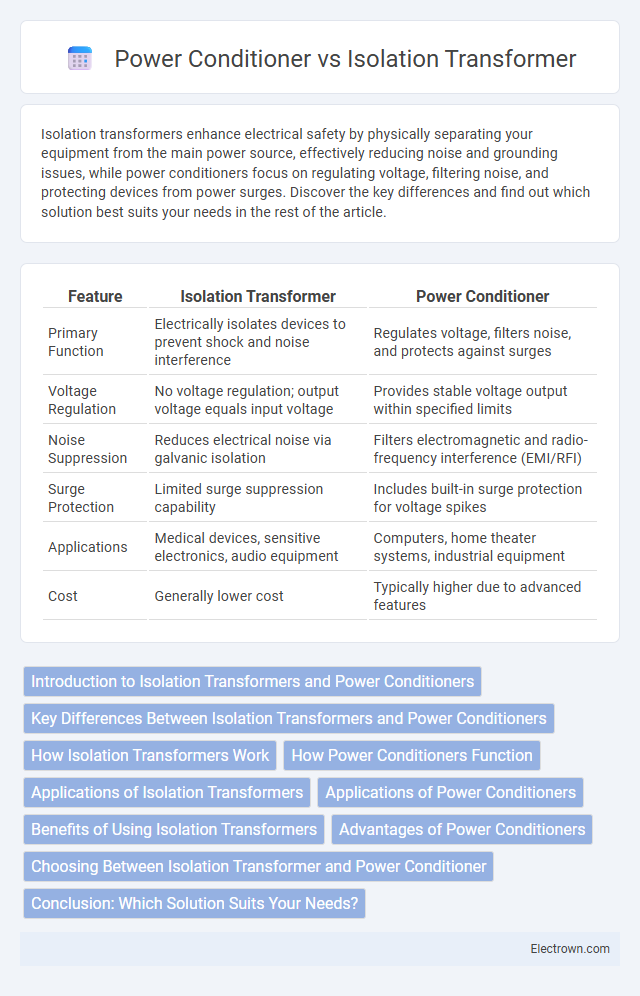Isolation transformers enhance electrical safety by physically separating your equipment from the main power source, effectively reducing noise and grounding issues, while power conditioners focus on regulating voltage, filtering noise, and protecting devices from power surges. Discover the key differences and find out which solution best suits your needs in the rest of the article.
Table of Comparison
| Feature | Isolation Transformer | Power Conditioner |
|---|---|---|
| Primary Function | Electrically isolates devices to prevent shock and noise interference | Regulates voltage, filters noise, and protects against surges |
| Voltage Regulation | No voltage regulation; output voltage equals input voltage | Provides stable voltage output within specified limits |
| Noise Suppression | Reduces electrical noise via galvanic isolation | Filters electromagnetic and radio-frequency interference (EMI/RFI) |
| Surge Protection | Limited surge suppression capability | Includes built-in surge protection for voltage spikes |
| Applications | Medical devices, sensitive electronics, audio equipment | Computers, home theater systems, industrial equipment |
| Cost | Generally lower cost | Typically higher due to advanced features |
Introduction to Isolation Transformers and Power Conditioners
Isolation transformers and power conditioners serve distinct roles in electrical systems, with isolation transformers primarily designed to prevent electrical noise and provide galvanic isolation by separating input and output circuits. Power conditioners focus on improving power quality by regulating voltage, filtering noise, and protecting sensitive equipment from surges and spikes. Understanding these differences helps you choose the right solution to enhance equipment performance and protect your electrical infrastructure.
Key Differences Between Isolation Transformers and Power Conditioners
Isolation transformers primarily provide electrical isolation and voltage transformation, reducing noise and protecting sensitive equipment from voltage spikes and ground loops. Power conditioners offer broader functions, including voltage regulation, surge protection, noise filtering, and sometimes battery backup, ensuring consistent power quality for your devices. Understanding these key differences helps you select the right solution to enhance equipment performance and longevity.
How Isolation Transformers Work
Isolation transformers work by magnetically coupling two separate coils of wire to transfer electrical energy without a direct electrical connection, effectively isolating the output from the input power source. This isolation helps to reduce electrical noise, prevent ground loops, and protect sensitive equipment from voltage spikes and surges. Unlike power conditioners, which filter and regulate voltage, isolation transformers provide galvanic isolation that ensures improved safety and noise reduction in electrical systems.
How Power Conditioners Function
Power conditioners improve your electrical system by filtering out voltage spikes, surges, and electromagnetic interference, ensuring clean and stable power delivery to sensitive equipment. They typically include components such as surge protectors, voltage regulators, and noise filters to maintain consistent voltage and protect devices from damage. By stabilizing the power supply, power conditioners enhance the performance and longevity of your electronic devices, unlike isolation transformers that primarily focus on electrical isolation.
Applications of Isolation Transformers
Isolation transformers are crucial in medical equipment, industrial machinery, and sensitive electronic devices where electrical noise reduction and safety from electrical shock are paramount. They provide galvanic isolation, preventing ground loops and ensuring clean power delivery in laboratory settings and audio systems. Common applications also include power supply for computers, telecommunications equipment, and hazardous environments requiring enhanced protection against electrical faults.
Applications of Power Conditioners
Power conditioners are essential in protecting sensitive electronic equipment from voltage fluctuations, electrical noise, and power surges commonly found in audiovisual setups, medical devices, and industrial machinery. They improve power quality by filtering electromagnetic interference (EMI) and radio frequency interference (RFI), ensuring consistent voltage delivery to your devices. Unlike isolation transformers, power conditioners offer integrated surge protection and noise reduction, making them ideal for environments with fluctuating power sources.
Benefits of Using Isolation Transformers
Isolation transformers provide superior electrical noise reduction by physically separating the input power source from sensitive equipment, enhancing overall signal integrity. They offer critical protection against electrical shocks and surges, safeguarding devices from voltage spikes and grounding issues commonly found in industrial and medical applications. This improved safety and noise mitigation make isolation transformers essential for maintaining the reliability and longevity of high-precision electronics.
Advantages of Power Conditioners
Power conditioners enhance electrical equipment performance by regulating voltage, filtering noise, and protecting against surges, providing a stable power supply. Unlike isolation transformers that primarily isolate circuits to reduce noise, power conditioners offer comprehensive power quality improvements essential for sensitive electronics. This ensures extended equipment lifespan, reduced downtime, and improved operational reliability in environments with fluctuating or contaminated power.
Choosing Between Isolation Transformer and Power Conditioner
Choosing between an isolation transformer and a power conditioner depends on your specific electrical needs and environment. An isolation transformer provides galvanic isolation to reduce electrical noise and protect sensitive equipment from voltage spikes, while a power conditioner enhances power quality by regulating voltage, filtering noise, and suppressing surges. Understanding your equipment's sensitivity and the quality of your power source will help you determine whether the focus should be on isolation or comprehensive conditioning to optimize your system's performance.
Conclusion: Which Solution Suits Your Needs?
An isolation transformer provides superior electrical noise reduction and protection from voltage spikes by physically separating your devices from the main power source, making it ideal for sensitive equipment requiring high-quality power. Power conditioners primarily regulate and filter voltage fluctuations and noise but may not offer the same level of isolation and surge protection. Your choice depends on whether your priority is absolute electrical isolation and safety or general voltage regulation and noise filtering.
isolation transformer vs power conditioner Infographic

 electrown.com
electrown.com